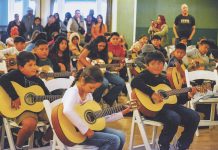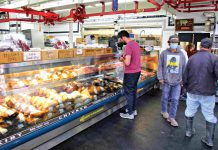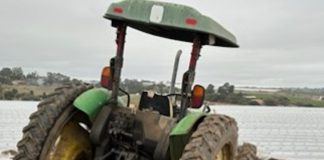
Every year, tens of thousands of people from across the globe gather in Nevada’s Black Rock Desert for Burning Man, an experimental festival focused on art, self-expression and community.
The week-long event has participants arrive with their own shelter, food and water, and supplies to make their own artistic creations. It climaxes with the burning of a massive human-shaped effigy.
This year is the first time Burning Man will be held since 2019, and amongst the many sculptures scattered across the desolate landscape is one created by Watsonville metal sculpture artist Pierre Rich.
Dubbed “Golden Possibilities,” the 10-foot-tall piece, made of sheets of cut metal, depicts a rearing palomino horse. When installed at Burning Man, it will be one of 10 horses that will make up “Wild Horses of the American West,” an exhibit aiming to raise awareness of wild horse populations.
According to the coalition, wild horse overpopulation in the West has resulted in environmental impacts, traffic fatalities and deaths of horses due to dried up water resources.
“I love sculpting horses because they are beautiful, powerful creatures, but also have an amazing historical connection to humans,” Rich said. “There are not enough resources to help wild horses right now … They are undervalued and overpopulated. We hope that this project will make a statement about what’s happening.”
Rich said he was able to create the piece through a grant from the Coalition for Healthy Nevada Lands. A friend told him about the grant only two days before the deadline, giving him just enough time to come up with a proposal.
“It’s not a huge grant, but enough to allow me to get some materials, and give me the incentive to devote the time to it,” he said. “I’d also just sold another big sculpture so I had enough resources and funds to keep me going.”
“Golden Possibilities” took Rich three months to complete. He worked on it nearly every day, preparing a template, creating a rough drawing, and manipulating sheets of laser/plasma cut steel sheets around the frame.
“At the end, it was a grind,” he said. “It was pretty stressful. But it worked out.”
Rich, who attended and participated in Burning Man off and on between 2006 and 2010, said the event provides opportunities for artists who might otherwise not have a space to display their work.
“[Burning Man] is special in terms of its ability to show off large scale pieces,” he said. “There are some amazing works there that you won’t see anywhere else. The high caliber for showcasing metal sculptures in particular is really incredible.”
Rich also highlighted the unique community of cooperation at the festival.
“People from all walks of life, from different financial statuses come to Burning Man,” he said. “It’s a real melting pot. It’s all about exploration.”
“Wild Horses of the American West” will include horse sculptures from 10 other artists, and eight additional artists who volunteered to build artworks to accompany the group. After Burning Man, which runs Aug. 28-Sept. 5, some of the sculptures will be transported and exhibited at the Reno/Tahoe International Art Fair in mid-September.
After that, Rich said, there are plans to place some of the pieces, including “Golden Possibilities” around the Reno area for six months. During that time, the pieces will be up for sale.
Rich said he hopes the exhibit will draw attention to the ongoing challenges for wild horses in the West, while also being inspiring to artists and art lovers.
“[The sculptures] should inspire awe,” he said, “not just for their artistry, but also for humans’ connection to horses, our coexistence.”
To learn more about Rich’s art, visit pierrericheart.com.











